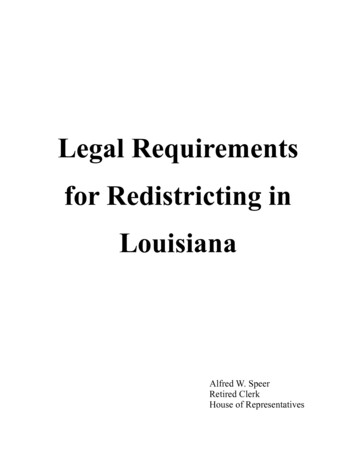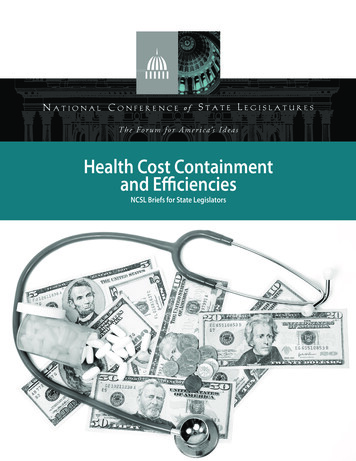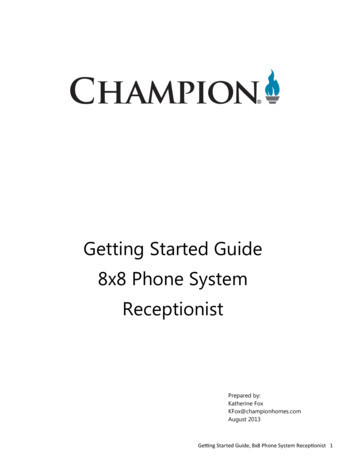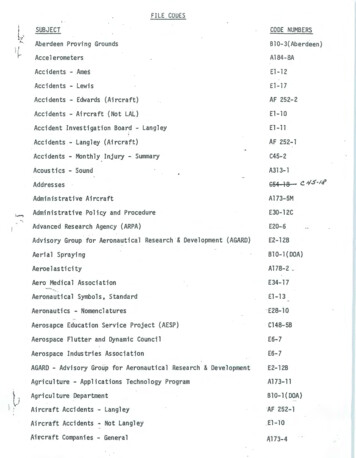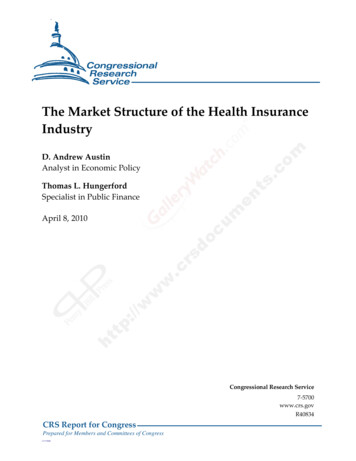
Transcription
.The Market Structure of the Health InsuranceIndustryD. Andrew AustinAnalyst in Economic PolicyThomas L. HungerfordSpecialist in Public FinanceApril 8, 2010Congressional Research Service7-5700www.crs.govR40834CRS Report for CongressPrepared for Members and Committees of Congressc11173008
.The Market Structure of the Health Insurance IndustrySummaryIn March 2010, after more than a year of legislative deliberation, Congress passed a pair ofmeasures designed to reform the U.S. health care system and address the twin challenges ofconstraining rapid growth of health care costs and expanding access to high-quality health care.On March 21, the House passed the Patient Protection and Affordable Care Act (H.R. 3590),which the Senate had approved on Christmas Eve, as well as the Health Care and EducationReconciliation Act of 2010 (H.R. 4872). President Obama signed the first measure (P.L. 111-148)on March 23 and the second on March 30 (P.L. 111-152). On November 2, 2009, the HouseJudiciary Committee reported out the Health Insurance Industry Antitrust Enforcement Act of2009 (H.R. 3596), which would limit antitrust exemptions provided by the McCarran-FergusonAct (P.L. 79-15).This report discusses how the current health insurance market structure affects the two policygoals of expanding health insurance coverage and containing health care costs. Concerns aboutconcentration in health insurance markets are linked to wider concerns about the cost, quality, andavailability of health care. The market structure of the health insurance and hospital industriesmay have contributed to rising health care costs and deteriorating access to affordable healthinsurance and health care. Many features of the health insurance market and the ways it links toother parts of the health care system can hinder competition, lead to concentrated markets, andproduce inefficient outcomes. Health insurers are intermediaries in the transaction of theprovision of health care between patients and providers: reimbursing providers on behalf ofpatients, exercising some control over the number and types of services covered, and negotiatingcontracts with providers on the payments for health services. Consequently, policies affectinghealth insurers will likely affect the other parts of the health care sector.The market structure of the U.S. health insurance industry not only reflects the nature of healthcare, but also its origins in the 1930s and its evolution in succeeding decades. Before World WarII, many commercial insurers doubted that hospital or medical costs were an insurable risk. Butafter the rapid spread of Blue Cross plans in the mid-1930s, several commercial insurers began tooffer health coverage. By the 1950s, commercial health insurers had become potent competitorsand began to cut into Blue Cross’s market share in many regions, changing the competitiveenvironment of the health insurance market.Evidence suggests that health insurance markets are highly concentrated in many local areas.Many large firms that offer health insurance benefits to their employees have self-insured, whichmay put some competitive pressure on insurers, although this is unlikely to improve marketconditions for other consumers. The exercise of market power by firms in concentrated marketsgenerally leads to higher prices and reduced output—high premiums and limited access to healthinsurance—combined with high profits. Many other characteristics of the health insurancemarkets, however, also contribute to rising costs and limited access to affordable health insurance.Rising health care costs, in particular, play a key role in rising health insurance costs.Complex interactions among health insurance, health care providers, employers, pharmaceuticalmanufacturers, tax policy, and the medical technology industry have helped increase health costsover time. Reducing the growth trajectory of health care costs may require policies that affectthese interactions. Policies focused only on health insurance sector reform may yield someresults, but are unlikely to solve larger cost growth and limited access problems. This report willbe updated as events warrant.Congressional Research Service
.The Market Structure of the Health Insurance IndustryContentsIntroduction .1How the Health Insurance Industry Developed .2How the “Blues” Began .3Tax Advantages For Employer-Provided Health Insurance Benefits.5Commercial Insurers Enter.5Introduction of Medicare and Medicaid.6The Rise of Managed Care.7Blurring Distinctions Between “Blues” and Commercial Insurers.8Description of the Health Insurance Market. 11Intermediaries Play Key Roles in Health Care . 12Demand for Health Insurance. 15Sources of Health Insurance Coverage . 16What People Know Differs: Information Problems in Insurance Markets. 16Price Effects. 20Tax Benefits. 21Supply of Health Insurance . 21Risk-Sharing . 21Administration . 22Types of Health Plans. 22Types of Insurance Companies . 22Role of Employers . 23Regulation of Health Insurers. 25Market Concentration Among Health Insurance . 25Measures of Market Concentration. 26DOJ-FTC Merger Guidelines . 26Market Concentration Among Health Insurers . 27Market Concentration and Market Power . 29Possible Causes of Concentration in the Health Insurance Market . 31The Spread of Managed Care . 31Countervailing Power. 32Economies of Scale. 32Marketing and Brand Management. 33Competitive Environment . 34Health Insurance Company Profitability . 34Financial Results and Ratios. 35Comparing Profitability By Industry . 36Profitability Measures Reported by the A.M. Best Company . 42Profitability Measures Reported by the Sherlock Company . 45Options for Congress . 47More Aggressive Antitrust Enforcement . 47Stronger Regulatory Measures. 49Regulation of Medical Underwriting . 49Minimum Loss Ratio Requirements . 50Individual and Employer Health Insurance Mandates . 50Health Insurance Exchanges. 51Congressional Research Service
.The Market Structure of the Health Insurance IndustryLessons from the Massachusetts Connector . 52What Role Would Exchanges Play: Traffic Cops vs. Gatekeepers . 52The Public Option. 52Cooperatives . 53Other Options . 55Concluding Remarks. 55FiguresFigure 1. National Health Expenditures By Source of Payment. 13Figure 2. Major Health Insurers’ Net Margins by Percentage ASO Enrollments . 37TablesTable 1. Top 30 Health Insurance Companies Ranked By Total Medical Enrollment . 10Table 2. Sources of Health Insurance Coverage, 2008. 16Table 3. Percentage of Private-Sector Establishments Offering Health Insurance ThatSelf-Insure At Least One Plan . 23Table 4. Two Profit Indicators for Fortune 1000 Firms By Industry, 2008 . 38Table 5. Medical Loss Ratios for Major Publicly Traded Health Insurers, 2000-2008. 43Table 6. Profit Margins of Health Plans . 46Table 7. Profit Margins of Blue Cross/Blue Shield Plans, 2008. 46Table 8. Profit Margins of National Commercial Insurers, 2008. 47Table 9. Profit Margins By Line of Health Insurance, 2008. 47Table A-1. Return on Equity for Major Publicly Traded Insurers, 2000-2008 . 58Table A-2. Return on Revenue for Major Publicly Traded Health Insurers, 2000-2008. 59Table A-3. Profits As a Percentage of Shareholder Equity By Industry for Fortune 1000Firms, 2008. 60AppendixesAppendix. Additional Indicators of Health Insurers’ Profitability. 57ContactsAuthor Contact Information . 63Congressional Research Service
.The Market Structure of the Health Insurance IndustryIntroductionIn March 2010, after more than a year of legislative deliberation, Congress passed a pair ofmeasures designed to reform the U.S. health care system and address the twin challenges ofconstraining rapid growth of health care costs and expanding access to high-quality health care.On March 21, the House passed the Patient Protection and Affordable Care Act (H.R. 3590),which the Senate had approved on Christmas Eve, as well as the Health Care and EducationReconciliation Act of 2010 (H.R. 4872).1 President Obama signed the first measure (P.L. 111148) on March 23 and the second on March 30 (P.L. 111-152).Other health reform proposals were also put forth, such as the Healthy Americans Act (S. 391),introduced by Senators Ron Wyden and Robert Bennett, and the Empowering Patients First Act(H.R. 3400), introduced by Representative Tom Price. On November 2, 2009, the House JudiciaryCommittee reported out the Health Insurance Industry Antitrust Enforcement Act of 2009 (H.R.3596), which would limit antitrust exemptions provided by the McCarran-Ferguson Act (P.L. 7915).2Health care costs in the United States, which have risen rapidly in real terms in the last fewdecades, have strained state and federal budgets. Future growth in health care costs is projected tothreaten the fiscal position of state and federal governments unless major policy changes occur.Additionally, for many Americans, the lack of health insurance coverage complicates access tohealth care. According to the U.S. Census Bureau, 46.3 million or 15.4% of the people in theUnited States lack health insurance coverage.3 Furthermore, even families with health insurancemay become vulnerable to the financial burdens of a serious health condition or illness eitherbecause of the narrowness of plan benefits or the unpredictability of decisions about what care iscovered. Increases in health insurance premiums, according to some research, has degradedaccess to health care.4Health insurance markets are often highly concentrated with one insurer accounting for over 50%of the market. Concerns about concentration in health insurance markets are linked to widerconcerns about the cost, quality, and availability of health care. The market structure of the healthinsurance and hospital industries may have played a role in rising health care costs and in limitingaccess to affordable health insurance and health care. Some argue market concentration has led tohigher health care prices. 5 Higher prices for health care or health care insurance may then make1CRS Report R41124, Medicare: Changes Made by the Reconciliation Act of 2010 to the Patient Protection andAffordable Care Act (P.L. 111-148), coordinated by Patricia A. Davis; CRS Report R41128, Health-Related RevenueProvisions: Changes Made by H.R. 4872, the Health Care and Education Reconciliation Act of 2010 , by JanemarieMulvey.2CRS Report R40968, Limiting McCarran-Ferguson Act’s Antitrust Exemption for the “Business of Insurance”:Impact on Health Insurers and Issuers of Medical Malpractice Insurance, by Janice E. Rubin and Baird Webel.3U.S. Census Bureau, “Health Insurance Coverage: 2008,” September 10, 2009, available at th08asc.html. See also CRS Report 96-891, Health Insurance Coverage: Characteristicsof the Insured and Uninsured in 2008, by Chris L. Peterson.4Todd Gilmer and Richard Kronick, “It’s The Premiums, Stupid: Projections of the Uninsured Through 2013,” HealthAffairs, Web Exclusive, April 5, 2005, available at hlthaff.w5.143/DC1.5For example, see American Medical Association, Competition in Health Insurance: A Comprehensive Study of U.S.Markets (Chicago: AMA, 2008), p. 1; and David Balto, “Why A Public Health Insurance Option Is Essential,” blogposting, Health Affairs, September 17, 2009.Congressional Research Service1
.The Market Structure of the Health Insurance Industryhealth care less affordable and thus less accessible for some families. Consumers in the individualand small group markets typically face particularly challenging conditions.Others, however, contend that health insurers with strong bargaining leverage might helpconstrain health providers’ ability to raise prices, and that the benefit of lower premiums resultingfrom that ability to bargain may be passed along to consumers. Some industry analysts havedescribed competition among major health insurers as robust, and some pricing trends indicatethat competition has strongly affected insurers’ market strategies. 6 Moreover, some contend thateconomies of scale along with state and federal regulation have contributed to the rising levels ofconcentration in health insurance markets.The Obama Administration has made reform of the American health insurance and health caresystem a top policy priority. Several congressional proposals aim to broaden access to health careby increasing the number of Americans with health insurance coverage, by lowering the cost ofinsurance faced by individuals, by providing stronger incentives for individuals to acquire healthinsurance, and by restructuring parts of the health insurance market. Some of these health reformproposals also contain measures intended to slow the growth of health care costs, although somepolicy analysts are uncertain whether current proposals are likely to accomplish that goal.7 Someargue that a more fundamental reform of the health care sector and the health insurance marketwould be needed to change the projected trajectory of health care costs.This report discusses whether or not the current health insurance market structure hinders the U.S.health system’s ability to reach the policy goals of expanding health insurance coverage andcontaining health care costs. The report describes the forces that have shaped the health insuranceindustry, including its historical evolution, characteristics of health care and health insurance,determinants of supply and demand for health insurance, and the nature of competition amonghealth insurers. Reasons for high market concentration are discussed, along with profitabilitymeasures for the industry. Finally, options for Congress regarding the health insurance industryare analyzed.How the Health Insurance Industry DevelopedThe market structure of the modern U.S. health insurance industry not only reflects thecomplexities and uncertainties of health care, but also its origins in the 1930s and its evolution insucceeding decades. Private insurers had offered accident, burial, and sickness policies in thelatter half of the 19th century, and some railroad, mining, and timber firms began to offerworkplace health benefits.8 As population shifted from rural agricultural regions to industrializedurban centers, workers were exposed to risks of occupational accidents, but had less support fromextended family networks that provided informal insurance benefits. Many workers obtainedaccident or sickness policies through fraternal organizations, labor unions, or private insurers.These policies were usually indemnity plans, that would pay a set cash amount in the event of a6One leading insurance rating agency recently described the commercial health sector as “very competitive.” A.M.Best Company, Multiple Issues Adversely Impact Health Care Results for 2008, May 4, 2009, p. 2.7Congressional Budget Office, The Budgetary Treatment of Proposals to Change the Nations Health InsuranceSystem, Economic and Budget Issue Brief, May 27, 2009.8Laura A. Scofea, “The Development and Growth of Employer-Provided Health Insurance,” Monthly Labor Review,vol. 117, no. 3 (March 1994), pp. 3-10.Congressional Research Service2
.The Market Structure of the Health Insurance Industryserious accident or health emergency.9 Social surveys at the turn of century spotlighted the linkbetween industrial accidents and poverty, leading Progressive-era reformers and labor unions topush for compulsory social insurance, which helped lead to workers’ compensation programs.10How the “Blues” BeganThe modern health insurance industry in the United States was spurred by the onset of the GreatDepression. In 1929, the Baylor University Hospital in Dallas created a pre-paid hospitalizationbenefit plan for school teachers after a hospital executive discovered that unpaid billsaccumulated by local educators were a large burden on hospital finances as well as on theteachers themselves. 11 Unlike earlier health insurance policies, subscribers were entitled tohospital care and services rather than a cash indemnity. While the plan did not cover physicianbills, it did improve enrollees’ ability to pay those charges.The Baylor Plan was soon extended to other groups. Other hospitals in Dallas quickly followedsuit with their own group hospitalization plans as a means of ensuring a steady revenue source indifficult economic times. 12 For individuals, these plans offered a way to obtain hospital care at areasonable and predictable cost. In 1932, local hospitals in Sacramento, CA, created a joint planfor group hospitalization benefits, and in 1933, hospitals in Essex County, New Jersey, offered asimilar plan. Community-based plans in St. Paul, MN, Washington, DC, and Cleveland werecreated soon afterwards. The Blue Cross emblem, first used by the St. Paul plan, was widelyadopted by other prepaid hospital benefit plans adhering to American Hospital Association(AHA) guidelines.The AHA’s 1933 guidelines required prepaid group hospitalization plans using the Blue Crosssymbol to stress the public welfare, limit benefits to hospital charges, organize as a non-profit,and run on a sound economic basis.13 While many of the early group hospitalization plans wereorganized by community leaders, voluntary hospitals controlled Blue Cross because theyprovided the key resources in most cases and because they were responsible for underwriting thepolicies.14 Through the 1930s, the number of Blue Cross plans grew and enrollments expanded.By 1937, 1 million subscribers were covered, and by 1939, 25 states had passed legislation toenable hospitalization plans. Many state laws deemed Blue Cross plans charitable communityorganizations that were exempted from certain insurance regulations and taxes.159For a discussion of insurance before the Great Depression, see David T. Beito, “‘This Enormous Army:’ The MutualAid Tradition of American Fraternal Societies Before the 20th Century,” in David T. Beito, Peter Gordon, andAlexander Tabarrok, eds., The Voluntary City (Ann Arbor, MI: Michigan University Press, 2002).10Crystal Eastman, Work-Accidents and the Law (New York: Survey Associates, 1910), available athttp://books.google.com/books/download/Work accidents and the law.pdf?id 0wAtAAAAYAAJ&output pdf&sig ACfU3U1rXY2JDamyzoybhpuDxNPKQ-Lr-Q&source gbs v2 summary r&cad 0; David Rosner and GeraldMarkowitz, “The Struggle over Employee Benefits: The Role of Labor in Influencing Modern Health Policy,” MilbankQuarterly, vol. 81, no. 1 (2003), pp. 45-73.11Robert D. Eilers, Regulation of Blue Cross and Blue Shield Plans (Homewood, IL: R.D. Irwin, 1963), pp. 10-11.12Robert Cunningham III and Robert M. Cunningham Jr., The Blues: A History of the Blue Cross and Blue ShieldSystem (Dekalb, IL: Northern Illinois University Press, 1997).13American Hospital Association, “Essentials of an Acceptable Plan for Group Hospitalization,” 1933.14Paul Starr, The Social Transformation of American Medicine (New York: Basic Books, 1983), pp. 296-297; Eilers, p.12.15Starr, p. 298.Congressional Research Service3
.The Market Structure of the Health Insurance IndustryThe health insurance market in the United States, according to many historians, was originallystructured to avoid competition among providers.16 The earliest plans tied benefits to a singlesponsoring hospital; each hospital plan competed with others. Groups or individuals with theoption to negotiate with specific hospitals might have been able to exert bargaining power.Hospital and professional groups, however, soon pushed for joint plans that required “free choiceof physicians and hospital,” rather than plans offered by individual hospitals. Joint plansdampened incentives for local hospitals to compete on the basis of price or generosity of planbenefits. The American Hospital Association strongly favored joint plans that allowed asubscriber to obtain care from any licensed local hospital and viewed single-hospital plans as athreat to the economic stability of community hospitals. Furthermore, in 1937, the AHA requiredBlue Cross plans to have exclusive territories so that they would not compete against each other.17Hospital and physician groups’ opposition to competition in health care and health insurancedovetailed with more general criticism of “destructive competition” that was widespread in theearly 1930s. Some business leaders and New Deal policymakers viewed heightened competitionas the cause of sharp cuts in wages, which in their view reduced consumer buying power anddrove price deflation and market instability during the early years of the Great Depression. 18 Mosteconomists believe measures to reduce market competition imposed during the Great Depressionactually retarded economic recovery.19 Competition in health insurance markets, however, raisesissues that do not apply in most markets. If health insurers adopt different underwriting standards,competition can make pooling risks more difficult, an issue discussed in more detail below.Insurance coverage of physician services lagged behind the growth of Blue Cross hospital plansdue to opposition from the American Medical Association (AMA) and restrictive state laws.20 Inseveral states, however, medical societies set up prepaid service plans to preempt proposed stateor federal plans, which evolved into Blue Shield plans. In most states, Blue Shield was absorbedinto Blue Cross plans, although some retained separate governing boards.Blue Cross plans accelerated their growth during World War II and extended to almost all statesby 1946.21 Wartime wage and price controls authorized in October 1942 excluded “reasonable”insurance and pension benefits.22 As industries struggled to expand war production, many16Rosemary Stevens, In Sickness and In Wealth: American Hospitals in the 20th Century (New York: Basic Books,1989), p. 156.17Starr, p. 297.18Anthony J. Badger, The New Deal: The Depression Years, 1933-1940 (New York: Hill and Wang, 1989), p. 75.19Carl Shapiro, Deputy Assistant Attorney General for Economics, Antitrust Division, U.S. Department of Justice,“Competition Policy In Distressed Industries,” Speech delivered at ABA Antitrust Symposium: Competition as PublicPolicy, May 13, 2009, available at m; Michael M. Weinstein,Recovery and Redistribution under the NIRA (Amsterdam: North-Holland, 1980); and Harold L. Cole and Lee E.Ohanian, “New Deal Policies and the Persistence of the Great Depression: A General Equilibrium Analysis,” Journalof Political Economy, vol. 112, no. 4 (August 2004), pp. 779-816. De Long and Summers contend that certain wageand price rigidities may help with macroeconomic stability in some situations, but admit that anticompetitive policies inthe early 1930s “may have had contractionary macroeconomic effects.” J. Bradford De Long and Lawrence H.Summers, “Is Increased Price Flexibility Stabilizing?” American Economic Review, vol. 76, no. 5 (December 1986),pp. 1031-1044.20Starr, pp. 306-309.21Testimony of C. Rufus Rorem, Executive Director, Hospital Service Plan Commission, in U.S. Congress, SenateCommittee on Education, 79th Cong., 2nd sess., 1946, available at http://www.sigmondpapers.org/shapers pdf/shapers appendix k.pdf.22Wage and price controls and the War Labor Board was authorized by the October 2, 1942, entitled “An Act to(continued.)Congressional Research Service4
.The Market Structure of the Health Insurance Industryemployers used health insurance and other fringe benefits to attract new workers. In the late1940s, the National Labor Relations Board (NLRB) successfully sued employers that refused tobargain collectively over fringe benefits, opening the way for unions to negotiate with employersover health insurance, which further helped boost enrollments in health insurance plans.23Tax Advantages For Employer-Provided Health Insurance BenefitsPrior to 1954, no explicit statutory provision excluded health insurance benefits from federalincome taxation.24 The IRS, however, had indicated in 1943 that group health insurancepremiums paid by a firm for its employees would be considered an “ordinary and necessary”business expense rather than as taxable income received by the employee. 25 A major overhaul ofthe Internal Revenue Code of 1954 included Section 106, which explicitly excluded employercontributions for health insurance from employees’ taxable income. The tax exclusion foremployer-provided health care made health insurance cheaper than non-tax-advantaged forms ofconsumption for individuals. One study found that health insurance coverage following the 1954tax changes expanded more rapidly among employees with higher incomes, who generally hadmarginal tax rates, which could indicate that the tax exclusion led workers to demand moreextensive or generous plans.26 Other factors, such as rising income levels, competition forworkers, and risi
Title: untitled Created Date: 4/8/2010 11:35:51 AM
